Overview of the TechnoLine BC-700 charger, or my experience with Ni-MH battery recovery

It so happened that after two years of active hobby for photography, I got a little forgotten about the whole thing. And now, a year later, about 3 weeks ago, I was “struck” in the photo. He took out a camera, batteries, ran for joy to take pictures. Took 2 photos, received a message: "Replace batteries . " “It doesn't happen to anyone, I seized a randomly discharged kit,” I thought. Put another set - one or two pictures and the camera asks for new batteries. So with all my four pairs of batteries. Without entering the situation, I went, stuck them in charge, while reading Habr for the night, I noticed that five minutes had not passed from the moment of installation to charging, and the LED of the charger already indicates full charging. From this moment the story began. Welcome under the cut!
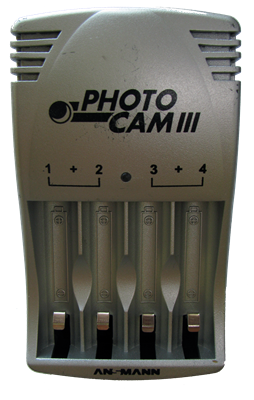
Together with the photo camera, as I already said, 8 AA Ni-MH rechargeable batteries with a capacity of 2850mAh from Ansmann were used . Charged them with what they were completed - with an Ansmann PhotoCam III charger (left).
I would not say that a bad charger, until I encountered this problem. Googling, I found out that the problem is that my batteries were charged for a very long time, and they lost their capacity very much. Honestly, I was pretty upset. A few more hours on Google, and I had a choice: to buy new batteries and not soar, or spend money on a smart charger that could restore battery capacity. New batteries - this, of course, quickly and without suffering, but with the usual inexpensive charging and my sudden inattention, they can quickly go for the already damaged ones. And then what? Money down the drain? It is worth noting that the price of 8 such batteries is equal to the price of a smart charger. Without thinking, I ordered the delivery of charging from the online store and went to sleep.
TechnoLine BC-700 in hand
 TechnoLine BC-700 can be safely attributed to the class of advanced, smart chargers. It can be used to charge batteries of type AA and AAA (finger and mini-boys). You can charge nickel-cadmium (Ni-Cd) as well as nickel-metal hydride (Ni-MH) batteries with a capacity of up to 3000mAh with currents of 200, 500 or 700mA. One of the main advantages is to work with each battery individually (in absolutely all parameters), while simple batteries can only charge a pair of batteries. Another interesting feature is the overheating sensor, which suspends the charging process until the temperature drops. The device has 4 operating modes: charging, discharging, restoration of batteries and their testing. In addition, during the memory operation, you can view information on the charge / discharge current, the voltage of each battery, the time spent on the current cycle, and the charged capacity of the battery.
TechnoLine BC-700 can be safely attributed to the class of advanced, smart chargers. It can be used to charge batteries of type AA and AAA (finger and mini-boys). You can charge nickel-cadmium (Ni-Cd) as well as nickel-metal hydride (Ni-MH) batteries with a capacity of up to 3000mAh with currents of 200, 500 or 700mA. One of the main advantages is to work with each battery individually (in absolutely all parameters), while simple batteries can only charge a pair of batteries. Another interesting feature is the overheating sensor, which suspends the charging process until the temperature drops. The device has 4 operating modes: charging, discharging, restoration of batteries and their testing. In addition, during the memory operation, you can view information on the charge / discharge current, the voltage of each battery, the time spent on the current cycle, and the charged capacity of the battery.')
Equipment
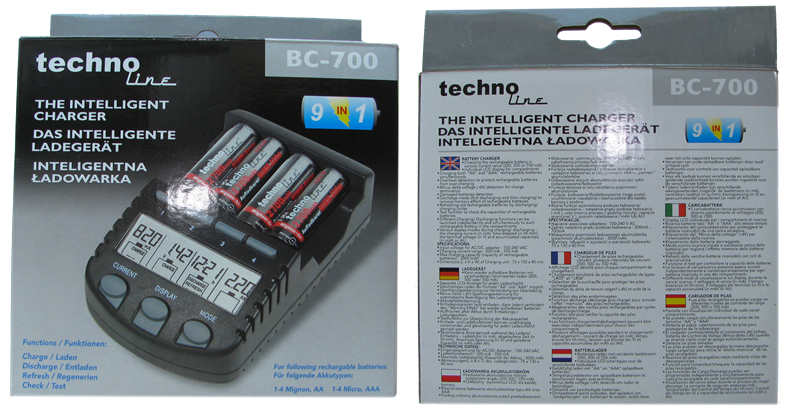
Comes in a regular cardboard box, inside:
- the charger itself;
- Power Supply;
- plug;
- manual;
- warranty card
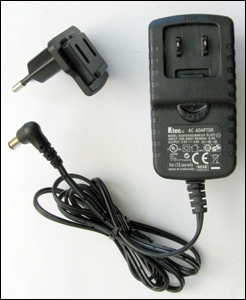 Grade, as you can see, a bit scarce. Personally, I do not have enough cover or handbags for transportation. The charger itself looks very cool. Plastic rough, durable enough (the fall from the table withstood without damage). Terminals are made with high quality, they hold batteries very tightly even after two weeks of use. Dimensions TechnoLine BC-700 is quite normal - 130x75x40 mm. The legs, unfortunately, are made of plastic, sliding on the table. The power supply is made with a very unusual trifle - a detachable plug. It is made, it seems, for ease of transportation.
Grade, as you can see, a bit scarce. Personally, I do not have enough cover or handbags for transportation. The charger itself looks very cool. Plastic rough, durable enough (the fall from the table withstood without damage). Terminals are made with high quality, they hold batteries very tightly even after two weeks of use. Dimensions TechnoLine BC-700 is quite normal - 130x75x40 mm. The legs, unfortunately, are made of plastic, sliding on the table. The power supply is made with a very unusual trifle - a detachable plug. It is made, it seems, for ease of transportation.
As already mentioned, the charger works with each battery separately. To implement the functionality on the front panel, we see 4 active slot selection buttons, a four-section LCD display, a button for setting the charging current (Current), a button for changing the displayed information (current, voltage, elapsed time, charged capacity) and a button for changing the operating mode. Here are the modes now and let's talk.
Modes of operation
Charging
So, the main mode of operation is charging. The mode allows you to charge your battery with currents of 200mA, 500mA or 700mA. When installing the battery into the compartment, the “charging” mode and the current of 200mA are automatically selected. On the screen of 4 seconds, the current voltage on the battery is displayed, then another 4 seconds we see the charging current. If during these 8 seconds you do not produce additional infusions, then the process will begin with exactly these parameters. If you produce - the process will begin 4 seconds after the last button is pressed. By the way, it is best to charge with a small current. The end of charging is determined by -ΔV. Below is a table "Time to charge batteries with different currents" from the instructions.| Battery type | Capacity | Charging current (mA) | Approximate charging time |
| AA | 2700mAh | 700 | ~ 3 hours 45 minutes |
| 500 | ~ 5 hours | ||
| 200 | ~ 13 hours | ||
| AAA | 1000mAh | 700 | ~ 1 hour |
| 500 | ~ 1 hour 25 minutes | ||
| 200 | ~ 3 hours 30 minutes |
Discharge
The second mode of operation of the BC-700 is discharging. This mode should be used if you plan for a long (more than 2 weeks) storage of batteries. Discharged batteries are stored almost without losing capacity. (I, unfortunately, learned about it very late.) Also, the mode is good for bringing fresh batteries to the nominal capacity. In this mode, the batteries are first discharged to 0.9V, and then charged to determine -ΔV. A partial disadvantage of the implementation of this mode in the BC-700 is charging performance after the battery is completely discharged. But, on the other hand, it is a convenient trifle for training your batteries. In order for the batteries to remain discharged, you need to catch the moment of transition to the charging mode and remove the battery. The discharge current is 50% of the charging current. Accordingly, when starting the “discharge” operating mode, it is necessary to take into account that, by choosing a discharge current of 350mA, our batteries will be charged with current 700mA, 250mA → 500mA, 100mA → 200mA, respectively. After the “discharge / charge” cycle is completed, the message Full will be displayed.Recovery (This is the mode that saved my batteries. But let's talk about the rescue procedure later. For now - a purely review.)
The mode is used to restore the capacity of old batteries that have not been used for a long time and keep their charge weak, not the way they should. The process consists of multiple discharge / charge cycles, which are designed to squeeze out of the old batteries all possible power. The cycles will be repeated until the capacity of the batteries stops increasing. Charging / discharging currents correspond to those described in the “discharge” section and are valid for the “recovery” mode. Immediately make a reservation that this mode restored my batteries for 5 days. Long, but effective.Testing
The mode serves to obtain information about the actual battery capacity. First there is a full discharge, then charging. This completes the function, and we get the actual value of the battery capacity. The choice of currents is similar to the previous two points and is valid in the "Testing" mode.My experience
 Now I will tell you about my experience of using this device. As mentioned at the beginning of the topic, there are 8 dead batteries, charging and patience car. After reading the manual, I realized that there is no special point in putting in the testing mode. I will also see the capacity of my “withered” batteries after the first discharge / charge cycle in recovery mode. Having put the first 4 batteries (the time was about one o'clock in the afternoon), I went on business. Returned to the clock by 7 pm, ran to look at the screen of the device. The second half of the first cycle, charging, had already taken place, and after another 2 hours I saw that the second cycle had begun. Then I did not think to write this topic, but I made a photo just for myself (therefore some pictures of dull quality) , in order to evaluate the effect of this mode. As can be seen in the photo, the capacity of all four batteries is approximately 200mAh, which is negligible and makes up about fourteenth of the nominal battery capacity. I was surprised at how bad the batteries were ...
Now I will tell you about my experience of using this device. As mentioned at the beginning of the topic, there are 8 dead batteries, charging and patience car. After reading the manual, I realized that there is no special point in putting in the testing mode. I will also see the capacity of my “withered” batteries after the first discharge / charge cycle in recovery mode. Having put the first 4 batteries (the time was about one o'clock in the afternoon), I went on business. Returned to the clock by 7 pm, ran to look at the screen of the device. The second half of the first cycle, charging, had already taken place, and after another 2 hours I saw that the second cycle had begun. Then I did not think to write this topic, but I made a photo just for myself (therefore some pictures of dull quality) , in order to evaluate the effect of this mode. As can be seen in the photo, the capacity of all four batteries is approximately 200mAh, which is negligible and makes up about fourteenth of the nominal battery capacity. I was surprised at how bad the batteries were ...Days passed, I glanced at the screen, contemplating the apparent restoration of battery capacity.
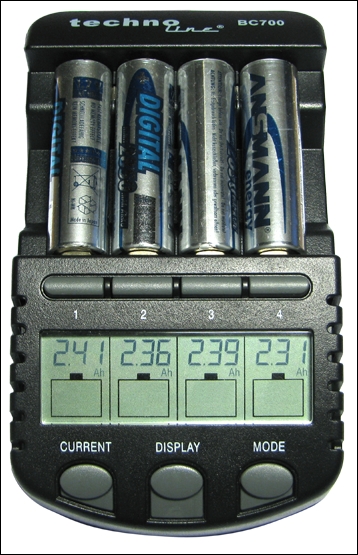 After 5 days after the start on the BC-700, I saw a joyful “Full”. When the current capacity was displayed on the screen, I, frankly, was surprised, happy and cheerful at the same time. For 5 days, the TechnoLine BC-700 managed to increase (or more precisely, restore) the battery capacity by 12 times, from ~ 200mAh to ~ 2400mAh. I think this is a terrific result. I am very pleased with both the result of the device and the device as a whole. Not a bit sorry that I forked over him, because more than a dozen times will be useful. By the way, for the kit that first went through the BC-700 the next day ~ 250 photos were taken. After another 5 days, 4 more of my batteries were restored. Charging restored their capacity is also about 12 times.
After 5 days after the start on the BC-700, I saw a joyful “Full”. When the current capacity was displayed on the screen, I, frankly, was surprised, happy and cheerful at the same time. For 5 days, the TechnoLine BC-700 managed to increase (or more precisely, restore) the battery capacity by 12 times, from ~ 200mAh to ~ 2400mAh. I think this is a terrific result. I am very pleased with both the result of the device and the device as a whole. Not a bit sorry that I forked over him, because more than a dozen times will be useful. By the way, for the kit that first went through the BC-700 the next day ~ 250 photos were taken. After another 5 days, 4 more of my batteries were restored. Charging restored their capacity is also about 12 times.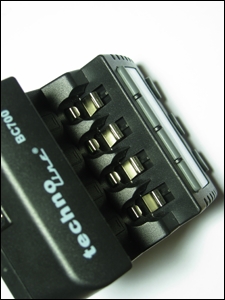
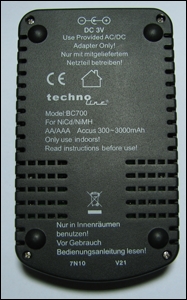

Conclusion
 Nice and interesting design
Nice and interesting design High quality battery clamps
High quality battery clamps Work with each battery individually
Work with each battery individually overheat protection
overheat protection Removable plug on the power supply (convenient to transport)
Removable plug on the power supply (convenient to transport) Determination of the completion of charging by -ΔV
Determination of the completion of charging by -ΔV Really recovers batteries that have not been used for a long time.
Really recovers batteries that have not been used for a long time. Reasonable price (~ $ 50)
Reasonable price (~ $ 50) Plastic legs
Plastic legs Lack of a cover / handbag for transportation
Lack of a cover / handbag for transportationTechnoLine BC-700 is an excellent charger that can charge your batteries wisely, keep them in working condition, restore already seemingly hopeless batteries. If you face the same choice as me: buy new batteries, or a charger, then I advise you to stop on the purchase of a TechnoLine BC-700 charger, especially considering that the cost of this charger is approximately equal to the cost of 8 batteries 2850mAh capacity more or less known brand.
Update 1: On Amazon, you can order an absolutely identical device made by La Crosse for $ 35.9. With us it costs about $ 50. Just do not forget that the plug will most likely not be for our outlets.
Source: https://habr.com/ru/post/123905/
All Articles